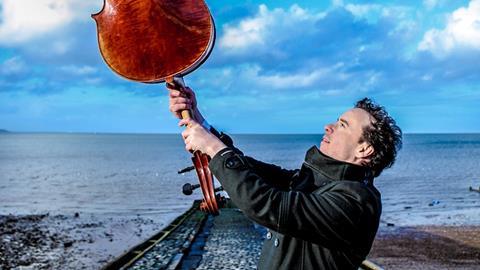The British artist uses the Greek word 'melos' - meaning both 'melody' and 'limb' - to explain the connection between movement and sound

So, you want to connect, communicate, reveal 'character' with your playing (the Three Cs).
This is how human beings do communication, according to the distinguished and oft-quoted Mehrabian model:
7% of meaning is in the words spoken
38% of meaning is paralinguistic (the way that the words are said)
55% of meaning is in facial expression/body language
For the purposes of this article, cue the musical analogy:
'Words' = 'notes'
'Way the words are said' = 'tone of instrument/voice'
'Facial expression/body language' = 'facial expression/body language'
'Words/notes'
Of course, textual fidelity - following the information in a score - is an important part of drilling down to and nuancing intention and inflection. As with any performance art, the text - the words, the notes, the steps - is the gateway to the meaning not the destination. Lots of critical language in music criticism addresses itself to these surface concerns. Pointing out 'right' or 'wrong' notes and the technique with which they are played is straightforward and quantifiable but, as Mehrabian makes clear, these phenomena are relatively insignificant in the scheme of communication - unless, of course, information and propriety are the things you want to communicate.
So, if your ultimate goal is the communication of music don't let this surface chatter distract you from deeper, more vital pursuits. Just execute the information and then, like Parsifal or Indiana Jones, use the information to lead you to The Grail. It's an adventure along the map of the score and also inwards to your viscera and your spirit.
I like Peter Brook's simple advice for not getting stuck on the surface:
'If you just let a play [piece of music] speak, it may not make a sound. If what you want is for the play to be heard, then you must conjure its sound from it. This demands many deliberate actions and the result may have great simplicity. However, setting out to 'be simple' can be quite negative, an easy evasion of the exacting steps to the simple answer.' (The Empty Space)
'Tone of instrument/voice'
A student asked me recently why sounds and interpretations in classical music seem currently so generic.
I think the antidote to 'genericity' (the generic sound/interpretation) is 'generosity'. Give generously of yourself to your sound-making. Give your sound generously to your audience. Don't stint. This is physical, visceral, spiritual work. Expect to feel drained and fulfilled. Gate-keepers may tell you to play less. Ignore them. Give generously to and of your sound and see/hear what arises. If you make sound from your viscera and your spirit, I guarantee it won't sound generic.
And it will be YOUR tone AND do 38% of what you want to communicate.
'Facial expression/body language'
The Greek word 'melos' means both 'melody' and 'limb'. In the Greek language, the sound is the same as the movement of the limb making that sound.
At the level of communication, the single, biggest disconnect I witness in performers of classical music between their essential selves and their audiences exists somewhere in the realm of 'melos' - the sound and the limb making the sound are not integrated, organic, rooted in the same place (the viscera, the spirit, the imagination). Both the Greek language (which knows a thing or two about story-telling) and Mehrabian make a simple, indefatigable case - if 'facial expression/body language' accounts for 55% of communication, then musicians must integrate sound and body.
So how do you align sound and limb?
I use the information of the score as both a sonic and a movement map. It's a fluid, porous, 'give and take' relationship between sound and body.
With instrument in hand, I ask questions like:
How does this music-making make me move? Is my concept of technique blocking this natural movement? Can I incorporate this natural movement into my concept of technique?
How can I move to do the information of the score more attentively? e.g. for cellists, can I zero in on the 'dance' or 'functionality' of my elbows to make this shift (i.e. opening of Prokofiev's Sinfonia Concertante) or this string crossing (i.e. Bach's E flat Prelude) more compelling? Practice this 'elbow dance'.
Does the sound-world of this phrase/work/composer impulse a movement-world in me? If I explore that movement-world (both with and without instrument), does it offer a more distinctive, idiosyncratic, characterful interpretation? Taking this approach may unlock technical issues and offer up previously unfore-heard sounds.
Away from the score, I also 'move to' and 'be moved' by the music - around the house, in the street, with my kids. I take this information back to the cello.
Watch clips of Wayne MacGregor choreographing, for instance:
Dance and sing like no one is watching/listening.
Baritone and cellist Matthew Sharp has been described as ‘virtuoso of the arts’ by The Times
In essence this blog is a celebration of first principles. Here are three videos that go there:
1. Tommy Foggo - Superhero
A one-man musical interactive for 7+ year olds and their adults:
https://youtu.be/GHJ1w3GNsgE
2. Finbar & The Shostakovich: my three-year-old son gets to grips with Shostakovich
3. Hora din budesti from ZRI's latest Schubert C major Quintet recording:
https://soundcloud.com/mattdjsharp/hora-din-budesti
Upcoming performances:
March 4th, 19.30
Guildford International Music Festival
ZRI To The Red Hedgehog - Schubert's C Major Quintet
March 12th, 14.00 & 18.30
York
Tommy Foggo – Superhero
A one-man interactive musical epic for 7+ yr olds and their adults
York venue & ticket details: www.matthewsharp.net PROJECTS
March 17th, 19.30
Stockport Town Hall
Shostakovich Cello Concerto No.1
Northern Chamber Orchestra
Photo: Raphael Klatzko
































No comments yet